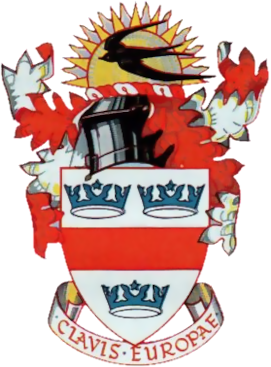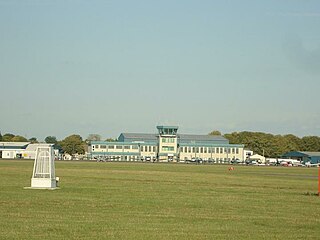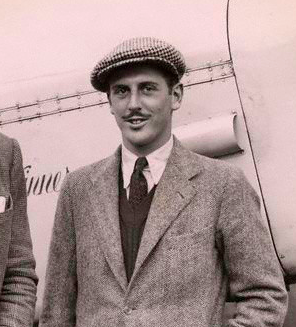Related Research Articles

Berlin Tempelhof Airport was one of the first airports in Berlin, Germany. Situated in the south-central Berlin borough of Tempelhof-Schöneberg, the airport ceased operating in 2008 amid controversy, leaving Tegel and Schönefeld as the two main airports serving the city for another twelve years until both were replaced by Berlin Brandenburg Airport in 2020.

The Bristol Type 175 Britannia is a retired British medium-to-long-range airliner built by the Bristol Aeroplane Company in 1952 to meet British civilian aviation needs. During development two prototypes were lost and the turboprop engines proved susceptible to inlet icing, which delayed entry into service while solutions were sought.
The Brabazon Committee was a committee set up by the British government in 1942 to investigate the future needs of the British Empire's civilian airliner market following World War II. The study was an attempt at defining, in broad overview, the impact of projected advances in aviation technology and to forecast the global needs of the post war British Empire and Commonwealth in the area of air transport, for passengers, mail, and cargo.

British European Airways (BEA), formally British European Airways Corporation, was a British airline which existed from 1946 until 1974.

Caledonian Airways was a wholly private, independent charter airline in the United Kingdom formed in April 1961. It began with a single 104-seat Douglas DC-7C leased from the Belgian flag carrier Sabena. Caledonian grew rapidly over the coming years to become the leading transatlantic "affinity group" charter operator by the end of the decade. During that period, passenger numbers grew from just 8,000 in 1961 to 800,000 in 1970. The latter represented 22.7% of all British non-scheduled passengers. It also became Britain's most consistently profitable and financially most secure independent airline of its era, never failing to make a profit in all its ten years of existence. By the end of 1970, Caledonian operated an all-jet fleet consisting of eleven aircraft and provided employment for over 1,000 workers. At that time, its principal activities included group charters between North America, Europe and the Far East using Boeing 707s, and general charter and inclusive tour (IT) activities in Europe utilising One-Elevens.

Dan-Air was an airline based in the United Kingdom and a wholly owned subsidiary of London-based shipbroking firm Davies and Newman. It was started in 1953 with a single aircraft. Initially, it operated cargo and passenger charter flights from Southend (1953–1955) and Blackbushe airports (1955–1960) using a variety of piston-engined aircraft before moving to a new base at Gatwick Airport in 1960, followed by expansion into inclusive tour (IT) charter flights and all-year round scheduled services. The introduction of two de Havilland Comet series 4 jet aircraft in 1966 made Dan-Air the second British independent airline after British United Airways to begin sustained jet operations.
British Airtours was a charter airline in the United Kingdom with flight operations out of London Gatwick and Manchester Airports.

The Vickers VC.1 Viking is a British twin-engine short-range airliner derived from the Vickers Wellington bomber and built by Vickers-Armstrongs Limited at Brooklands near Weybridge in Surrey. After the Second World War, the Viking was an important airliner with British airlines, pending the development of turboprop aircraft like the Viscount. An experimental airframe was fitted with Rolls-Royce Nene turbojets and first flown in 1948 as the world's first pure jet transport aircraft. Military developments were the Vickers Valetta and the Vickers Varsity.

Mike Bannister is an airline pilot. He is best known as the Chief Pilot of British Airways' Concorde fleet, a post which he held from 1995 until its withdrawal from service in 2003.

Airwork Limited, also referred to during its history as Airwork Services Limited, is a wholly owned subsidiary company of VT Group plc. It has a long and rich history in providing a variety of defence support services to the Royal Air Force (RAF), Fleet Air Arm and overseas air forces, as well as having played an important role in the development of civil aviation – both in the United Kingdom and abroad.

British Eagle International Airlines was a major British independent airline that operated from 1948 until it went into liquidation in 1968. It operated scheduled and charter services on a domestic, international and transatlantic basis over the years.

The Airways flying club was formed in 1948 under the name of the Airways Aero Club, by employees of British European Airways (BEA) and British Overseas Airways Corporation (BOAC). The club is operated by Airways Aero Associations Ltd, and flies out of Wycombe Air Park.

CAE Oxford, part of CAE Inc., is an ab initio flight training network. It provides integrated aviation training and resourcing services. Professional airline pilots have been trained at the Oxford Aviation Academy (OAA) flight school since 1961.

Cambrian Airways was an airline based in the United Kingdom which ran operations from Cardiff Airport and Liverpool John Lennon Airport between 1935 and 1974. It was incorporated into British Airways when BOAC, BEA, Cambrian and Northeast merged on 1 April 1974.

Bristol (Whitchurch) Airport, also known as Whitchurch Airport, was a municipal airport in Bristol, England, three miles (5 km) south of the city centre, from 1930 to 1957. It was the main airport for Bristol and the surrounding area. During World War II, it was one of the few civil airports in Europe that remained operational, enabling air connections to Lisbon and Shannon and onwards to the United States.
Air Service Training (AST) is an organisation in Perth, Scotland, that has been training engineers and pilots for airlines, maintenance organisations and the military since 1931. It is owned by Perth College UHI, with training taking place on the college campus and at Perth Airport, near Scone. In addition to holding a UKCAA Part 147 Approved Basic Training Approval AST Also holds Direct Foreign EASA Part 147 Basic Training Approval and Nepalese NCAR 147 Approval.

Sir Giles Connop McEachern Guthrie, 2nd Baronet, was an English aviator, merchant banker and later, an airline industry executive, serving as the chairman and chief executive of the state owned airline British Overseas Airways Corporation (BOAC).

British Overseas Airways Corporation (BOAC) was the British state-owned airline created in 1939 by the merger of Imperial Airways and British Airways Ltd. It continued operating overseas services throughout World War II. After the passing of the Civil Aviation Act 1946, European and South American services passed to two further state-owned airlines, British European Airways (BEA) and British South American Airways (BSAA). BOAC absorbed BSAA in 1949, but BEA continued to operate British domestic and European routes for the next quarter century. The Civil Aviation Act 1971 merged BOAC and BEA, effective 31 March 1974, forming today's British Airways.
Athelstan Sigfrid Mellersh Rendall OBE, known to his friends as Flaps Rendall, was a British pilot.
Hugh Palliser Kingsley Dibley is a former commercial airline pilot and trainer who made contributions toward conserving fuel and controlling noise during aircraft operations. He was also a successful racing car driver and race car constructor.
References
http://www.flightglobal.com/FlightPDFArchive/1967/1967%20-%200386.jpg